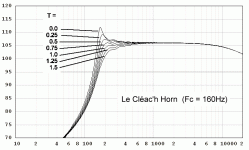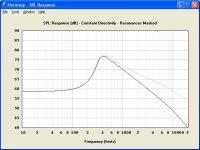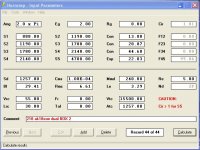HORNRESP VERSION 22.20
Hi Everyone,
Hornresp Version 22.20 has just been released. Eg can now be set to 0. A zero value for Eg means that the driver diaphragm has a constant rms velocity of 10 centimetres per second (option suggested by Jean-Michel).
Product Number 2220-090619 refers.
Kind regards,
David
Hi Everyone,
Hornresp Version 22.20 has just been released. Eg can now be set to 0. A zero value for Eg means that the driver diaphragm has a constant rms velocity of 10 centimetres per second (option suggested by Jean-Michel).
Product Number 2220-090619 refers.
Kind regards,
David
wow, you keep putting out new versions faster than I drink coffee (well, almost  ) Thanks a lot!
) Thanks a lot!
maybe it was already asked somewhere in the previous 25 pages, but would it be possible if the number of segments is variable and the input sheet adjusted accordingly? and have a bit more than 4 segments?
another, probably more difficult to answer question, could stuffing be added to each segment? this may not be important to the typical horn, but for the TL fraction out here this is very important.
 ) Thanks a lot!
) Thanks a lot!maybe it was already asked somewhere in the previous 25 pages, but would it be possible if the number of segments is variable and the input sheet adjusted accordingly? and have a bit more than 4 segments?
another, probably more difficult to answer question, could stuffing be added to each segment? this may not be important to the typical horn, but for the TL fraction out here this is very important.
your program is full of those little gems, I love it more every dayDavid McBean said:..... The volume of each segment is of course already given on the main Schematic Diagram when the mouse pointer is moved over the segment. The total system volume is also shown (see attached).
 only having a brief manual and discovering features as you go has it's charmes
only having a brief manual and discovering features as you go has it's charmes 
Re: HORNRESP VERSION 22.20
Hello David,
Thanks a lot for all the work you do to give a solution - when possible- to such requests as mines.
The constant velocity diaphragm will be very useful to compare horns without the influence of the driver.
Here attached the response of Le Cléac'h horns having the same cut-off frequency (Fc = 160Hz) and different T values (from 0 to 1.5)
Best regards from Paris, France
Jean-Michel Le Cléac'h
Hello David,
Thanks a lot for all the work you do to give a solution - when possible- to such requests as mines.
The constant velocity diaphragm will be very useful to compare horns without the influence of the driver.
Here attached the response of Le Cléac'h horns having the same cut-off frequency (Fc = 160Hz) and different T values (from 0 to 1.5)
Best regards from Paris, France
Jean-Michel Le Cléac'h
David McBean said:Hi Everyone,
Hornresp Version 22.20 has just been released. Eg can now be set to 0. A zero value for Eg means that the driver diaphragm has a constant rms velocity of 10 centimetres per second (option suggested by Jean-Michel).
Product Number 2220-090619 refers.
Kind regards,
David
Attachments
Henkjan said:Maybe it was already asked somewhere in the previous 25 pages, but would it be possible if the number of segments is variable and the input sheet adjusted accordingly? and have a bit more than 4 segments?
Another, probably more difficult to answer question, could stuffing be added to each segment? this may not be important to the typical horn, but for the TL fraction out here this is very important.
Hi Henkjan,
Your first question has been asked previously - see Post #478 for my answer.
As I recall, your second question has also been asked before - the answer is effectively the same as that given for question one
Kind regards,
David
Henkjan said:Only having a brief manual and discovering features as you go has it's charmes
Hi Henkjan,
All features are documented in the Hornresp Help file. It should not be necessary to discover anything
Kind regards,
David
Re: Re: HORNRESP VERSION 22.20
Hi Jean-Michel,
It looks good. The results are as expected .
.
Kind regards,
David
Jmmlc said:Here attached the response of Le Cléac'h horns having the same cut-off frequency (Fc = 160Hz) and different T values (from 0 to 1.5)
Hi Jean-Michel,
It looks good. The results are as expected
Kind regards,
David
David McBean said:Only if it doesn't require too much work - I'll have a look and see what would be involved.
Hi Cordraconis,
Further to my post above, just confirming that volume details will be added to the Horn Segment Wizard in the next release.
Kind regards,
David
Re: Re: Re: Re: HORNRESP VERSION 22.10
Hi Jean-Michel,
Further to the above, the attached screenprint shows the constant directivity power response of a TD2001 driver and Le Cléac’h horn (320Hz, T = 0,8) with a constant diaphragm acceleration of 1000 cm/sec2. The equivalent on-axis pressure response is shown in grey.
Based on these results, I am not sure that there would be much to be gained by including a constant acceleration option in the production version of Hornresp. Do you agree?
Kind regards,
David
David McBean said:I'm not sure how much work would be involved - I will investigate further.
Hi Jean-Michel,
Further to the above, the attached screenprint shows the constant directivity power response of a TD2001 driver and Le Cléac’h horn (320Hz, T = 0,8) with a constant diaphragm acceleration of 1000 cm/sec2. The equivalent on-axis pressure response is shown in grey.
Based on these results, I am not sure that there would be much to be gained by including a constant acceleration option in the production version of Hornresp. Do you agree?
Kind regards,
David
Attachments
mhtplsh said:warning message for the above post HR input.
Let me know my mistake.
Hi mhtplsh,
Please note that the message you are seeing is an advisory one only. Hornresp still works okay for multiple segment horns with Cir > 1, it's just that the results become less accurate as Cir increases above 1.
Kind regards,
David
David McBean said:
Hi Cordraconis,
Further to my post above, just confirming that volume details will be added to the Horn Segment Wizard in the next release.
Kind regards,
David
 Thank you very much!
Thank you very much!when I'll do another bDEAP (or equivalent), this will speed things up greatly!
You don't need to answer this, but will the volume details only be about the given Horn Segment, or about the whole horn incl back- and frontchamber?
Another thing I just think about: I've had some limited programming experience years ago, and I know there ought to be some sort of global variables from inside your program. What are your toughts about creating a small floating window in which you can create a custom simple calculation based on some of those variables?
In my case, this would be something like:
"External Pathlength of bDEAP with 22cm diam. driver is=" SQRT (#TotalSystemVolume / 22)
Where "TotalSystemVolume can be built from #Seg1Vol +#Seg2Vol + #BckChVol + #FrontChVol etc ...
This can be usefull for people with particular folding schemes and also to generate an extended "program state" in case an error or crash occurs for easier troubleshooting.
Re: Re: Re: Re: Re: HORNRESP VERSION 22.10
Hello David,
Acceleration being the derivative of velocity it is quite normal to obtain that 10dB slope. It was expected.
As I don't have any measurement of the power response of the TAD TD2001 on a Le Cléac'h horn, what interest me is to compare my frequency reponse curves measured by me at various angle from the axis, with the simulated response (HR directivity tool).
If the set of curve evolves differently with the off axis angle then probably we can say that the discrepancy between the response curves measured off axis and the ones simulated by Hornresp is due to a certain distribution of the pressure field at the driver throat.
Now if they are similar we must probably ask us why the simulation done using acceleration is better...
Ref: paragraph 3.2.1 in Mark Dodd's paper
(to calculate the on axis and off axis response he applied a j omega factor to the response in constant velocity...)
http://www2.kef.com/resources/whitepapers/uniq.pdf
Best regards from Paris, France
Jean-Michel Le Cléac'h
Hello David,
Acceleration being the derivative of velocity it is quite normal to obtain that 10dB slope. It was expected.
As I don't have any measurement of the power response of the TAD TD2001 on a Le Cléac'h horn, what interest me is to compare my frequency reponse curves measured by me at various angle from the axis, with the simulated response (HR directivity tool).
If the set of curve evolves differently with the off axis angle then probably we can say that the discrepancy between the response curves measured off axis and the ones simulated by Hornresp is due to a certain distribution of the pressure field at the driver throat.
Now if they are similar we must probably ask us why the simulation done using acceleration is better...
Ref: paragraph 3.2.1 in Mark Dodd's paper
(to calculate the on axis and off axis response he applied a j omega factor to the response in constant velocity...)
http://www2.kef.com/resources/whitepapers/uniq.pdf
Best regards from Paris, France
Jean-Michel Le Cléac'h
David McBean said:
Based on these results, I am not sure that there would be much to be gained by including a constant acceleration option in the production version of Hornresp. Do you agree?
Kind regards,
David
Hi Cordraconis,
The volume details shown on the Horn Segment Wizard will apply to the given horn segment only - it is less confusing that way. The total system volume information will of course still be provided on the Schematic Diagram.
I realise that you would probably prefer to have the total system volume on the Horn Segment Wizard also, but I want to confine information on the Wizard solely to the segment under consideration.
This is not going to happen .
.
Kind regards,
David
Cordraconis said:Will the volume details only be about the given Horn Segment, or about the whole horn incl back- and frontchamber?
The volume details shown on the Horn Segment Wizard will apply to the given horn segment only - it is less confusing that way. The total system volume information will of course still be provided on the Schematic Diagram.
I realise that you would probably prefer to have the total system volume on the Horn Segment Wizard also, but I want to confine information on the Wizard solely to the segment under consideration.
Cordraconis said:What are your thoughts about creating a small floating window in which you can create a custom simple calculation based on some of those variables?
This is not going to happen
Kind regards,
David
Re: Re: Re: Re: Re: Re: HORNRESP VERSION 22.10
Hello David,
Your graph shows a 20dB/decade slope not a 10dB/decade slope as I wrote eroneously.
Best regards from Paris, France
Jean-Michel Le Cléac'h
Hello David,
Your graph shows a 20dB/decade slope not a 10dB/decade slope as I wrote eroneously.
Best regards from Paris, France
Jean-Michel Le Cléac'h
Jmmlc said:Hello David,
Acceleration being the derivative of velocity it is quite normal to obtain that 10dB slope. It was expected.
As I don't have any measurement of the power response of the TAD TD2001 on a Le Cléac'h horn, what interest me is to compare my frequency reponse curves measured by me at various angle from the axis, with the simulated response (HR directivity tool).
If the set of curve evolves differently with the off axis angle then probably we can say that the discrepancy between the response curves measured off axis and the ones simulated by Hornresp is due to a certain distribution of the pressure field at the driver throat.
Now if they are similar we must probably ask us why the simulation done using acceleration is better...
Ref: paragraph 3.2.1 in Mark Dodd's paper
(to calculate the on axis and off axis response he applied a j omega factor to the response in constant velocity...)
http://www2.kef.com/resources/whitepapers/uniq.pdf
Best regards from Paris, France
Jean-Michel Le Cléac'h
too bad... fire up Akabak then....David McBean said:Hi Henkjan,
Your first question has been asked previously - see Post #478 for my answer.
As I recall, your second question has also been asked before - the answer is effectively the same as that given for question one.
why take the fun out of discoveries by reading a manualDavid McBean said:Hi Henkjan,
All features are documented in the Hornresp Help file. It should not be necessary to discover anything.

- Home
- Loudspeakers
- Subwoofers
- Hornresp






